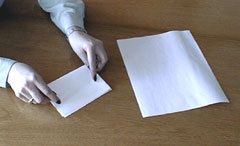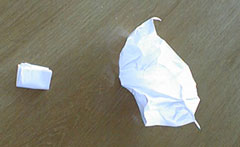Experiment - Air Resistance
In Adventures in Skydiving [1] Philippe Theys says
"Who would be crazy enough to leave a perfectly good airplane, accelerate for eleven seconds to reach a terminal velocity, where the pull of gravity equals wind resistance, of almost 200 kilometers per hour (125 miles per hour)?"
As we learn in the article, many people do - and love it! At terminal velocity, of course, these jumpers open a parachute and float to the ground. Once the parachute is opened, velocity is reduced to only 6 meters per second, or about 22 kph -- slow enough to land safely. The total mass of Philippe + parachute is the same, but with the parachute spread above him rather then folded up tightly in his back pack, the air resistance is much greater.
Here's a little experiment that demonstrates how this works.
Materials
- Two pieces of paper, the same size
- Cellophane tape
The Experiment
- Fold one piece of paper in half
- Fold it in half again. The second fold should be at a 90° angle to the first fold.
- Rotate the paper 90° and again fold it in half.
- Continue to fold the paper in half until you can't make another fold. Tape it tightly together with cellophane tape so that it does not unfold.


- Put a piece of cellophane tape on the second piece of paper. It should be the same length as the piece of tape you used on the first piece of paper. This tape doesn't hold anything. It's just there so that the two pieces of paper end up with exactly the same mass.
- Loosely crumple the second piece of paper.
What do you expect to happen when you drop both pieces of paper from the same height?
This content has been re-published with permission from SEED. Copyright © 2025 Schlumberger Excellence in Education Development (SEED), Inc.
Course:
- Science [5]
